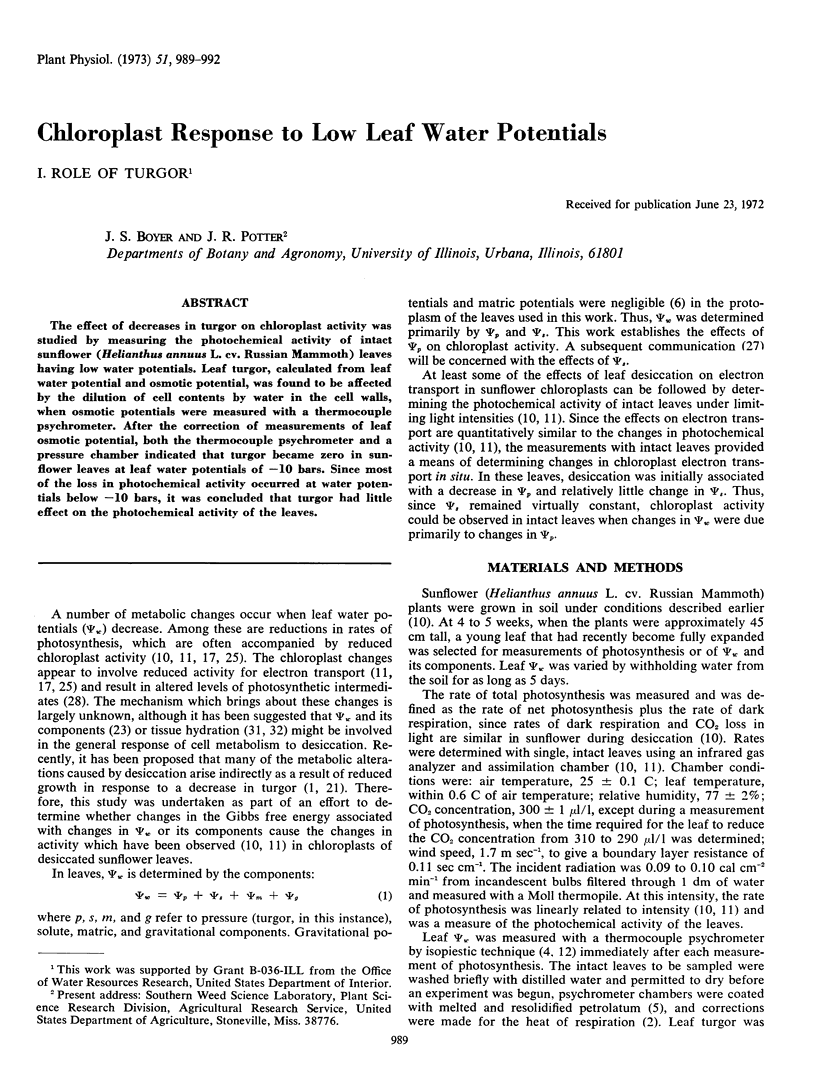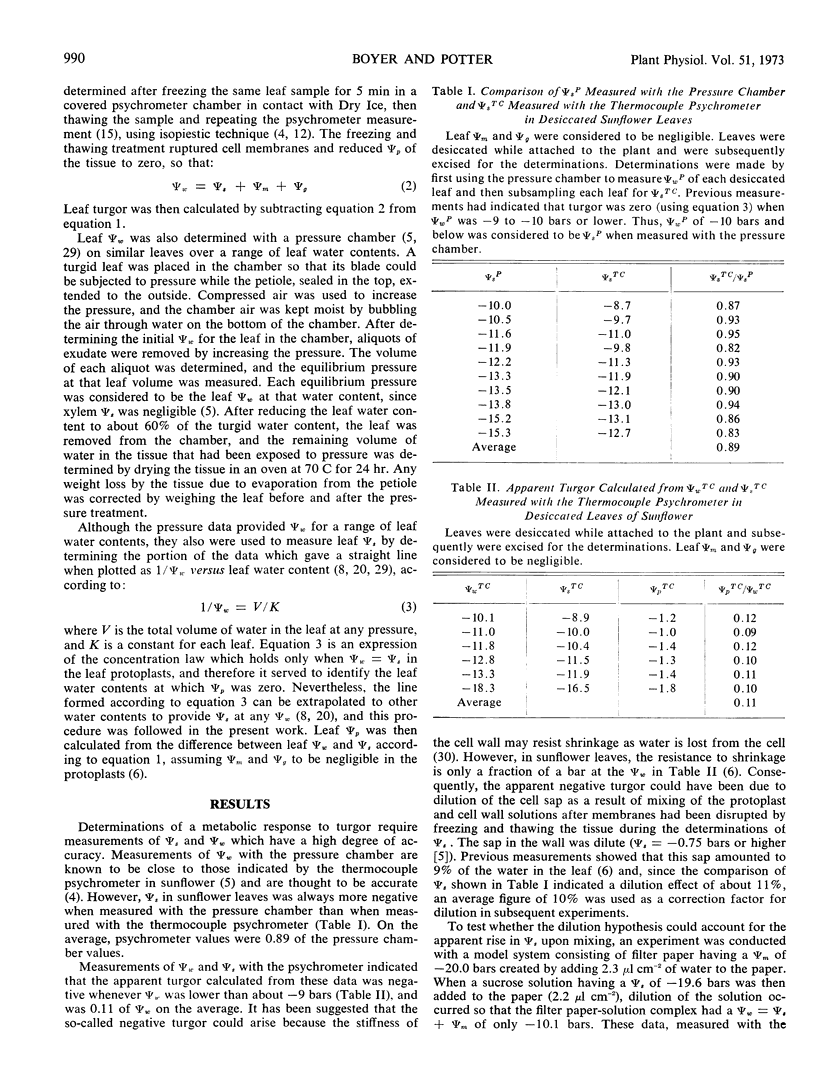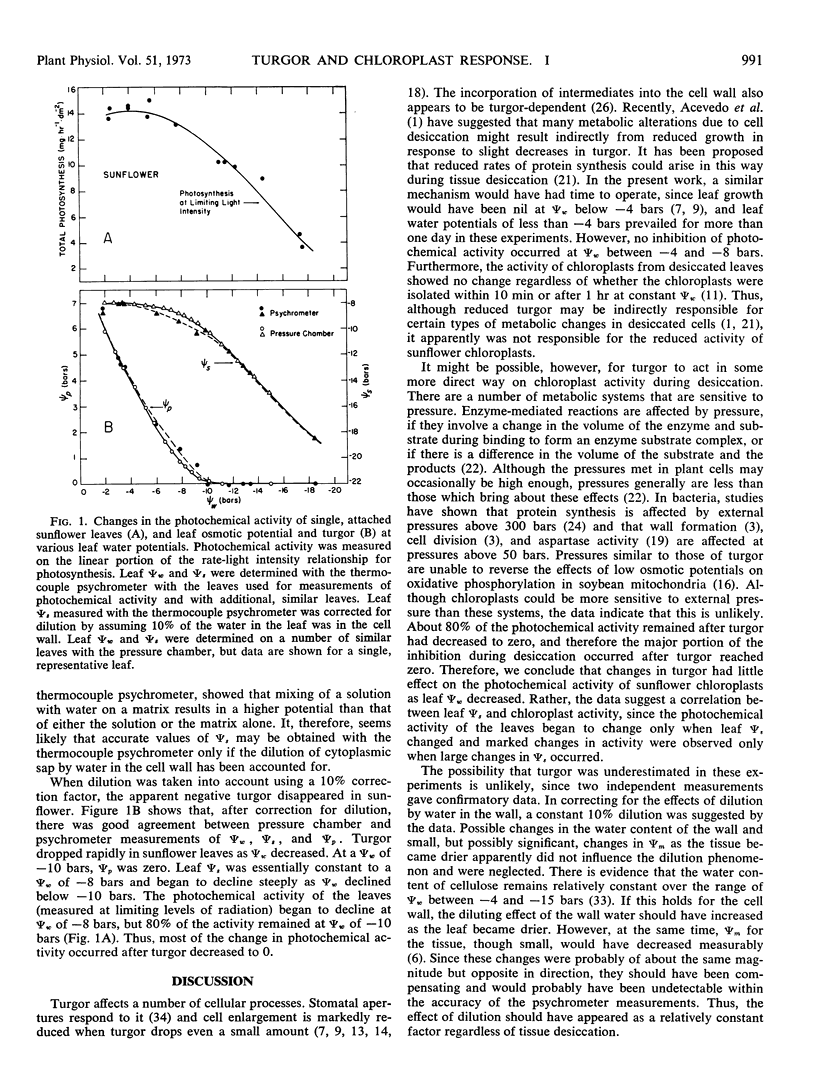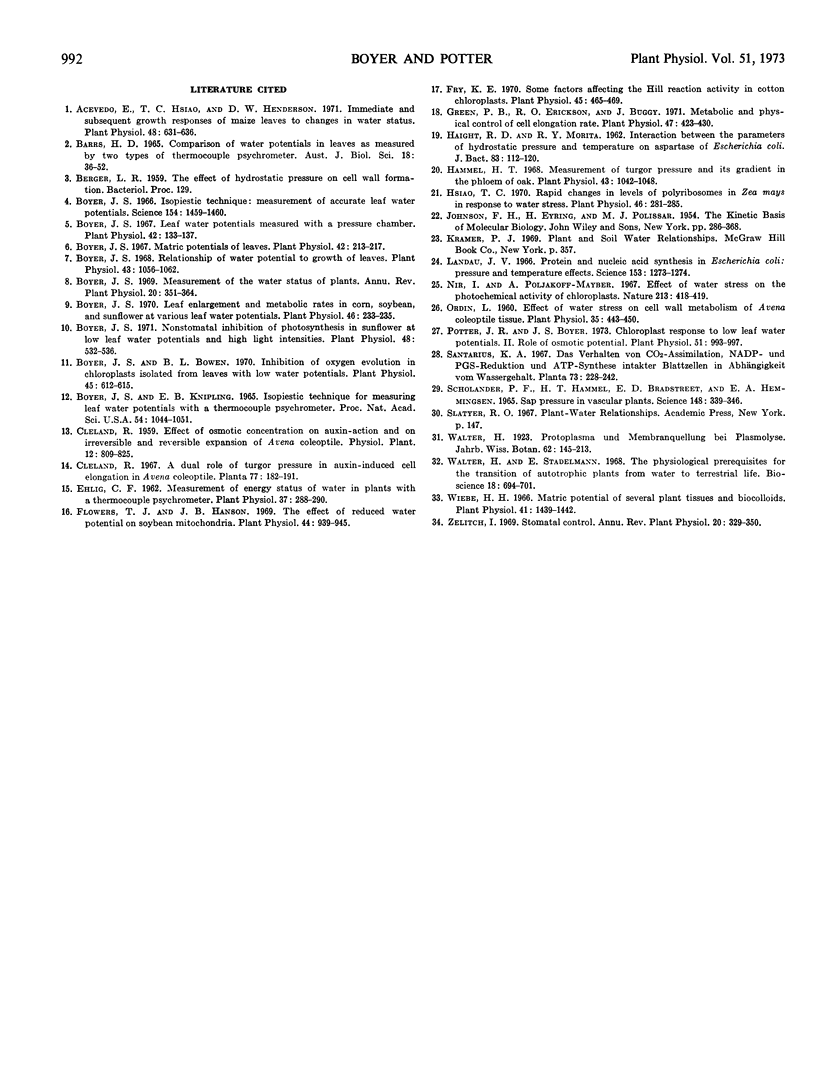Abstract
The effect of decreases in turgor on chloroplast activity was studied by measuring the photochemical activity of intact sunflower (Helianthus annuus L. cv. Russian Mammoth) leaves having low water potentials. Leaf turgor, calculated from leaf water potential and osmotic potential, was found to be affected by the dilution of cell contents by water in the cell walls, when osmotic potentials were measured with a thermocouple psychrometer. After the correction of measurements of leaf osmotic potential, both the thermocouple psychrometer and a pressure chamber indicated that turgor became zero in sunflower leaves at leaf water potentials of −10 bars. Since most of the loss in photochemical activity occurred at water potentials below −10 bars, it was concluded that turgor had little effect on the photochemical activity of the leaves.
Full text
PDF



Selected References
These references are in PubMed. This may not be the complete list of references from this article.
- Acevedo E., Hsiao T. C., Henderson D. W. Immediate and subsequent growth responses of maize leaves to changes in water status. Plant Physiol. 1971 Nov;48(5):631–636. doi: 10.1104/pp.48.5.631. [DOI] [PMC free article] [PubMed] [Google Scholar]
- Boyer J. S., Bowen B. L. Inhibition of oxygen evolution in chloroplasts isolated from leaves with low water potentials. Plant Physiol. 1970 May;45(5):612–615. doi: 10.1104/pp.45.5.612. [DOI] [PMC free article] [PubMed] [Google Scholar]
- Boyer J. S. Isopiestic technique: measurement of accurate leaf water potentials. Science. 1966 Dec 16;154(3755):1459–1460. doi: 10.1126/science.154.3755.1459. [DOI] [PubMed] [Google Scholar]
- Boyer J. S. Leaf enlargement and metabolic rates in corn, soybean, and sunflower at various leaf water potentials. Plant Physiol. 1970 Aug;46(2):233–235. doi: 10.1104/pp.46.2.233. [DOI] [PMC free article] [PubMed] [Google Scholar]
- Boyer J. S. Leaf water potentials measured with a pressure chamber. Plant Physiol. 1967 Jan;42(1):133–137. doi: 10.1104/pp.42.1.133. [DOI] [PMC free article] [PubMed] [Google Scholar]
- Boyer J. S. Matric potentials of leaves. Plant Physiol. 1967 Feb;42(2):213–217. doi: 10.1104/pp.42.2.213. [DOI] [PMC free article] [PubMed] [Google Scholar]
- Boyer J. S. Nonstomatal inhibition of photosynthesis in sunflower at low leaf water potentials and high light intensities. Plant Physiol. 1971 Nov;48(5):532–536. doi: 10.1104/pp.48.5.532. [DOI] [PMC free article] [PubMed] [Google Scholar]
- Boyer J. S. Relationship of water potential to growth of leaves. Plant Physiol. 1968 Jul;43(7):1056–1062. doi: 10.1104/pp.43.7.1056. [DOI] [PMC free article] [PubMed] [Google Scholar]
- Ehlig C. F. Measurement of Energy Status of Water in Plants With a Thermocouple Psychrometer. Plant Physiol. 1962 May;37(3):288–290. doi: 10.1104/pp.37.3.288. [DOI] [PMC free article] [PubMed] [Google Scholar]
- Flowers T. J., Hanson J. B. The effect of reduced water potential on soybean mitochondria. Plant Physiol. 1969 Jul;44(7):939–945. doi: 10.1104/pp.44.7.939. [DOI] [PMC free article] [PubMed] [Google Scholar]
- Fry K. E. Some factors affecting the Hill reaction activity in cotton chloroplasts. Plant Physiol. 1970 Apr;45(4):465–469. doi: 10.1104/pp.45.4.465. [DOI] [PMC free article] [PubMed] [Google Scholar]
- Green P. B., Erickson R. O., Buggy J. Metabolic and physical control of cell elongation rate: in vivo studies in nitella. Plant Physiol. 1971 Mar;47(3):423–430. doi: 10.1104/pp.47.3.423. [DOI] [PMC free article] [PubMed] [Google Scholar]
- HAIGHT R. D., M ORITA R. Y. Interaction between the parameters of hydrostatic pressure and temperature on aspartase of Escherichia coli. J Bacteriol. 1962 Jan;83:112–120. doi: 10.1128/jb.83.1.112-120.1962. [DOI] [PMC free article] [PubMed] [Google Scholar]
- Hammel H. T. Measurement of turgor pressure and its gradient in the Phloem of oak. Plant Physiol. 1968 Jul;43(7):1042–1048. doi: 10.1104/pp.43.7.1042. [DOI] [PMC free article] [PubMed] [Google Scholar]
- Hsiao T. C. Rapid Changes in Levels of Polyribosomes in Zea mays in Response to Water Stress. Plant Physiol. 1970 Aug;46(2):281–285. doi: 10.1104/pp.46.2.281. [DOI] [PMC free article] [PubMed] [Google Scholar]
- Landau J. V. Protein and nucleic acid synthesis in Escherichia coli: pressure and temperature effects. Science. 1966 Sep 9;153(3741):1273–1274. doi: 10.1126/science.153.3741.1273. [DOI] [PubMed] [Google Scholar]
- Ordin L. Effect of Water Stress on Cell Wall Metabolism of Avena Coleoptile Tissue. Plant Physiol. 1960 Jul;35(4):443–450. doi: 10.1104/pp.35.4.443. [DOI] [PMC free article] [PubMed] [Google Scholar]
- Potter J. R., Boyer J. S. Chloroplast Response to Low Leaf Water Potentials: II. Role of Osmotic Potential. Plant Physiol. 1973 Jun;51(6):993–997. doi: 10.1104/pp.51.6.993. [DOI] [PMC free article] [PubMed] [Google Scholar]
- Scholander P. F., Bradstreet E. D., Hemmingsen E. A., Hammel H. T. Sap Pressure in Vascular Plants: Negative hydrostatic pressure can be measured in plants. Science. 1965 Apr 16;148(3668):339–346. doi: 10.1126/science.148.3668.339. [DOI] [PubMed] [Google Scholar]
- Twente J. W., Twente J. A. Regulation of hibernating periods by temperature. Proc Natl Acad Sci U S A. 1965 Oct;54(4):1044–1051. [PMC free article] [PubMed] [Google Scholar]
- Wiebe H. H. Matric potential of several plant tissues and biocolloids. Plant Physiol. 1966 Nov;41(9):1439–1442. doi: 10.1104/pp.41.9.1439. [DOI] [PMC free article] [PubMed] [Google Scholar]


